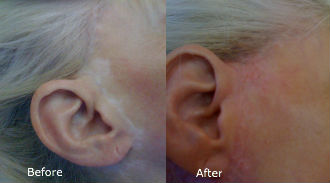Five remedial uses for micropigmentation
Cleft lip cover
Problem: Discolouration and scarring of the skin above the top lip
Solution: Using micropigmentation on cleft palette scarring can involve various elements – pigmenting the lips themselves as well as possibly the skin around the lips, and dry needling the scar. Caron Vetter, a partner at Whitethorn Fields Mediclinic, explains that for many clients, this is a potentially life-changing procedure, so therapists need to be confident in their experience.
“If someone comes to me with a cleft lip then I will make sure the line I create for them is even on both sides before I do it,” says Christina Pegg, founder of Hibiscus Beauty Clinic in Buckinghamshire, which also offers training in micropigmentation. “This is an area where there is no margin for error. If you make a mistake it will be very costly and time consuming to correct.”
“All micropigmentation treatments require two appointments, one month apart, but cleft lips can occasionally need a third,” adds Vetter. “As you are tattooing in to lip tissue and scar tissue, it may require a number of treatments to get the balance in the lip outline.”
Scar covering
Problem: Discolouration in the skin as a result of trauma, such as burns, stretch marks or surgery
Solution: Cathy Brown, head medical trainer at Nouveau Contour, recommends dry needling without pigment to help break down scar tissue, smooth skin, and encourage natural melanocyte production to even out colour. “The client needs to understand that a scar is not healthy, intact skin, so it can either hold or reject colour. That’s why we need to build colour up over several sessions,” she warns, a dding that dry needling first can help skin to accept pigment. However, as Teresa Frake, a micropigmentation trainer at Beauty Concepts International, says, it’s important to wait for a scar to fully heal before attempting micropigmentation, which could mean waiting up to a year from when the trauma was sustained. “A patch test should be performed using pigments of several different tones to find the best match. This is then left to heal for six weeks before checking colour and commencing treatment,” Frake explains.
dding that dry needling first can help skin to accept pigment. However, as Teresa Frake, a micropigmentation trainer at Beauty Concepts International, says, it’s important to wait for a scar to fully heal before attempting micropigmentation, which could mean waiting up to a year from when the trauma was sustained. “A patch test should be performed using pigments of several different tones to find the best match. This is then left to heal for six weeks before checking colour and commencing treatment,” Frake explains.
Vitiligo camouflage
Problem: Hypo-pigmentation of the skin (patchy loss of pigment), thought to be caused by an immune system condition
Solution: When using micropigmentation to camouflage vitiligo, it’s crucial to get an accurate enough colour match to remove the demarcation between the affected skin and normal skin. “Extremely large areas are not possible to camouflage since the discomfort, commitment and expense would make the programme too difficult,” warns Simpson. She recommends multiple treatment sessions and annual maintenance.
“The first thing to try and do is manage clients’ expectations,” says Brown. “On skin that hasn’t had any trauma, the best you can do is colour match and blend it into the surrounding area. It works well on people with dark skin tones, so even by putting colour that is not an exact match, you can make it easier for clients to use conventional make-up.”
When it comes to selecting colour, Simpson explains that patch testing should be done at least a month prior to the full treatment to assess the true healed colour of the pigment. Likewise, she says, clients should wait until their vitiligo has been in remission for at least three years before receiving micropigmentation treatment.
 Hair simulation
Hair simulation
Problem: Thinning hair on the head as a result of hormonal imbalances
Solution: We’re familiar with using micropigmentation to enhance brows, and now that same principle is being applied to treat the appearance of thinning hair on the scalp. “Most women [who suffer with hair loss] have diffuse hair loss,” explains Anouska Cassano, founder of Hair Ink, which specialises in micropigmentation for hair simulation. “This means an overall thinning in all areas of the scalp, including the sides and back.” She says you should expect the treatment to last between one and three years, meaning it’s possible to adjust the colour of the pigment according to any changes in the client’s hair as they age.
However, she stresses that because micro-pigmentation creates the illusion of hair density, rather than replacing actual hair, it’s most effective when used alongside a hair transplant. Tracy Simpson, director of Natural Enhancement Permanent Makeup, agrees, saying that in areas where hair loss is most severe, implanted pigment could look artificial. “Micropigmentation can enhance the results of hair transplants by camouflaging the donor site scars and shading the bare patches between grafts,” she adds.
Nipple reconstruction
Problem: Nipples lost as a result of mastectomy
Solution: Treating this area is as much about the psychological benefits and emotional care of clients as it is about the procedure itself. “By applying the areola and nipple through micropigmentation after mastectomy, the breasts are made to look more natural and even,” says Frake.
Vetter, who also trains NHS nurses in areola restoration, agrees. “Breasts form a strong part of women’s identities and to have them altered or to lose them altogether can be emotionally devastating,” she says. “By the time I meet clients, they may be feeling very fragile and weathered, so you need experience to treat them on an emotional level.”
Not all clients seeking this procedure will be cancer sufferers, however. Vetter adds that with breast augmentation operations now often performed through the areola, micropigmentation can be used to treat scarring on this area post surgery
Before and after images courtesy of: Natural Enhancement (top) and BCI (below).

